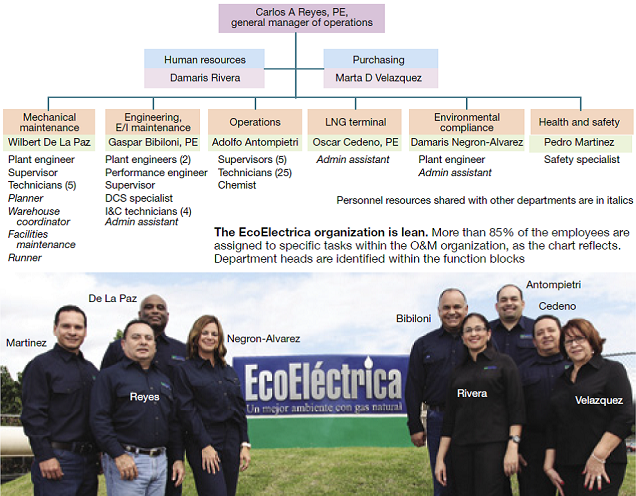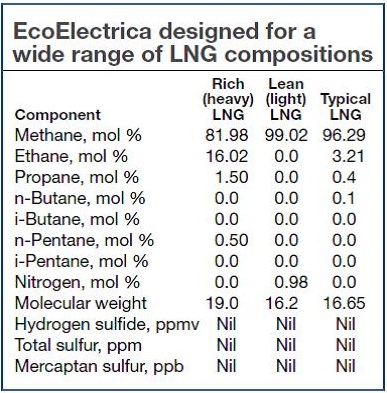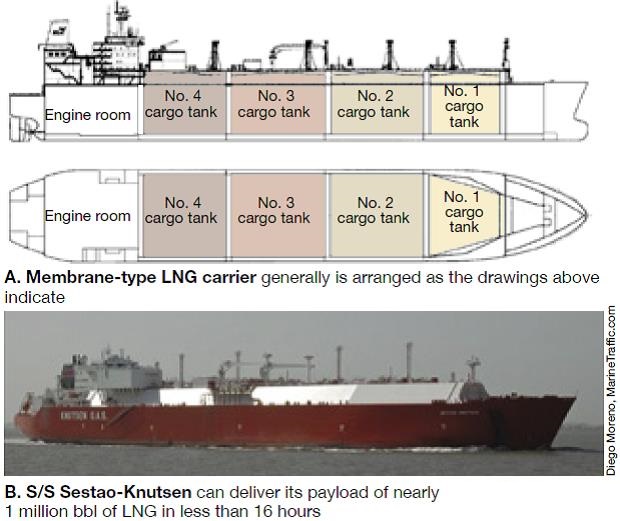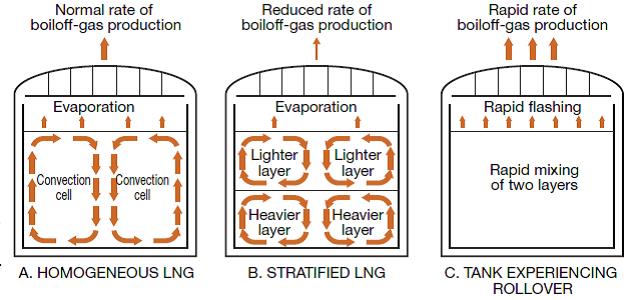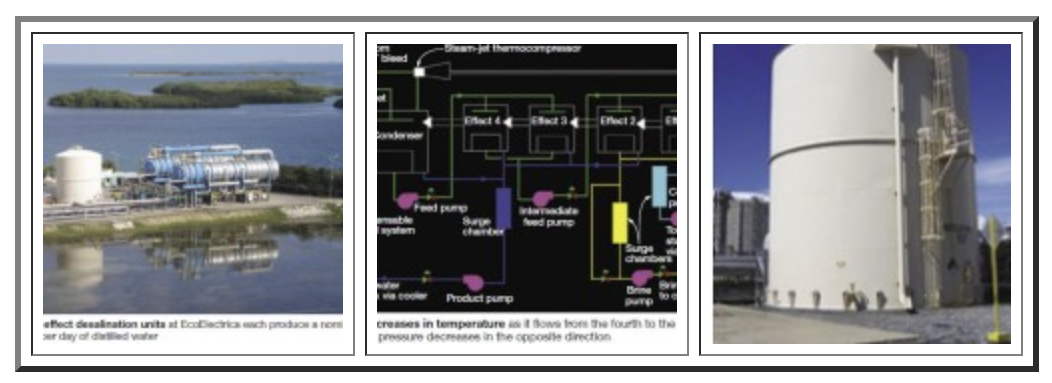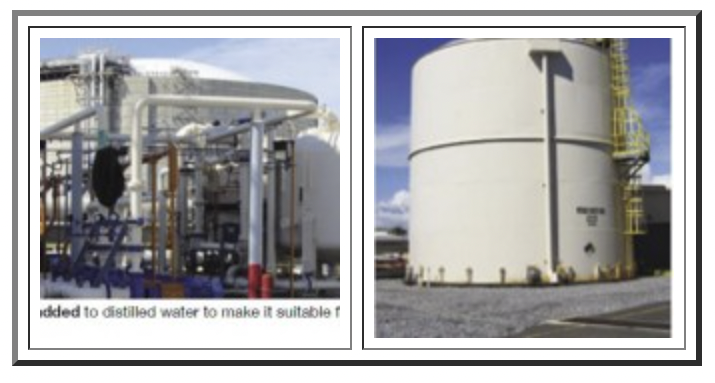| 1. Talented, empowered staff the force behind EcoElectrica’s success
EcoElectrica’s primary business objective is to provide reliable, flexible, and efficient energy production and tolling services while excelling in safety, environmental preservation, regulatory compliance, and community relations. These words are not window-dressing: They are the personal goals of the dedicated employees who make this electric generating facility in Penuelas, PR, world-class. Day-to-day leadership of EcoElectrica is provided by co-general managers: Carlos A Reyes, PE, for operations; Jaime Sanabria for finance and administration. They report to a Board of Directors representing the three owners: GDF Suez, Mitsui & Co Ltd, and Gas Natural Fenosa. The facility is staffed by 78 employees, the majority assigned to O&M of the power block, desalination plant, and LNG terminal (chart). Approximately 90% of EcoElectrica’s personnel are “locals,” living within about 30 minutes of the plant. One-third of the employees have Bachelor’s degrees, 10% Master’s degrees, and one a Doctorate. This is highly unusual in the power generation business today. Several first-line managers also are licensed professional engineers as the O&M org chart attests. |
|
2. LNG backgrounder
Natural gas is composed primarily of methane, but may also contain ethane, propane, and heavier hydrocarbons. Small quantities of nitrogen, oxygen, carbon dioxide, sulfur compounds, and water also may be found in pipeline natural gas, but they are removed during liquefaction. LNG usually is referred to as light or heavy depending on its methane content, which ranges from about 82% (heavy) to 99% (light) depending on the source and type of processing. The methane fraction for a typical shipment received by EcoElectrica from its primary supplier, Atlantic LNG Co of Trinidad, is in the neighborhood of 96%. The table presents the range of LNG compositions used in the design of the EcoElectrica terminal. The composition of LNG changes during tanker transport because some of it evaporates. The more volatile methane evaporates faster than the heavier hydrocarbon components, thereby increasing the gross calorific value of the fuel. Effects of ageing should be considered by the user prior to delivery, especially if a long voyage is involved. LNG tanks always are of double-wall construction with an efficient insulation system between the walls. Large tanks (EcoElectrica’s is 42-million gal) are cylindrical in design and have a domed roof; they are characterized by a low ratio of height to diameter. Storage pressures in these tanks are low—less than 5 psig, according to CH-IV engineers. LNG must be maintained cold— below about minus 180F—to remain a liquid, independent of pressure. Small tanks, those having a capacity of 70,000 gal or less, generally are horizontal or vertical vacuum-jacketed pressure vessels. Range of design pressures for these containers extends from less than 5 to more than 250 psig. The insulation, as efficient as it may be, will not keep the LNG reservoir in its liquid state. CH-IV experts explain that LNG is stored as a “boiling cryogen”—that is, as a very cold liquid at its boiling point for the storage pressure maintained. They suggest thinking of stored LNG as analogous to boiling water—only 470 deg F colder. The temperature of an open pot of boiling water does not change, even when more heat is applied, because it is cooled by evaporation. In much the same way, the experts continue, LNG will remain at near constant temperature if maintained at constant pressure—a phenomenon called “auto-refrigeration.” As long as the LNG boil-off gas (BOG as it is called) is allowed to leave the storage tank, the temperature remains constant. If BOG were not removed, then the pressure inside the tank would rise. Example: At 100 psig, LNG temperature would be minus 200F. However, the cost of building a 1-million-bbl pressure vessel for LNG storage would be prohibitively expensive. Safety. No discussion on the handling and storage of any fuel is complete without a thorough review of safety history, procedures, and best practices. The most serious US accident involving LNG occurred in Cleveland in 1944 before the behavior of cryogenic liquids in storage was well understood. The space program contributed significantly to the collective knowledge on cryogenics and post-Cleveland there have been only two safety incidents related to domestic LNG facilities, according to CH-IV research:
CH-IV International offers a detailed history of accidents at LNG facilities onshore and offshore worldwide on its website at www.ch.iv.com. In addition, and perhaps more importantly, its experts discuss the mechanics of gas explosions—including the vaporization of LNG spills and the mixing of the resulting vapor with air, ignition sources, and ignition of an LNG vapor cloud. |
|
3. Regulatory oversight focuses on safety, environmental protection Integrating an LNG terminal with a powerplant significantly increases the number of regulations and permits governing facility design and operation compared to those required for a standalone combined cycle. Plus, with more federal and local agencies involved, there’s greater regulatory oversight of facility operations to assure compliance with the additional rules. Here’s a list of the regulatory agencies monitoring activities at EcoElectrica and what their responsibilities are: Federal agencies Federal Energy Regulatory Commission (FERC) approval is required for the siting of new onshore LNG facilities. The Energy Policy Act of 2005 designates FERC as the “lead agency for the purposes of coordinating all federal authorizations” and the agency responsible for complying with federal requirements under the National Environmental Policy Act of 1969. FERC also is responsible for monitoring the safety and security of operating LNG facilities on an ongoing basis, coordinating its efforts with the US Coast Guard (USCG) and the Dept of Transportation (DOT). While DOT and FERC have agreed that the former has exclusive authority to promulgate federal safety standards for LNG facilities, the latter can issue more stringent safety requirements when it believes they are warranted. The agency monitors LNG terminal activities in accordance with 18CFR153, “Applications for Authorization to Construct, Operate, or Modify Facilities Used for the Export or Import of Natural Gas”; 18CFR380, “Regulations Implementing the National Environmental Policy Act”; and NFPA 59A, “Standard for the Production, Storage, and Handling of LNG.” Compliance involves semiannual reporting and an annual audit. Dept of Homeland Security (DHS)/ US Coast Guard (USCG) assure facility security compliance in accordance with 33CFR101, “Maritime Security: General”; 33CFR105, “Maritime Security: Facilities”; and 33CFR127, “Waterfront Facilities Handling LNG.” The USCG acts as a cooperating agency in the evaluation of LNG terminal applications and has the authority to review, approve, and verify plans for marine traffic around proposed onshore LNG terminals as part of the overall siting approval process led by FERC. Annual inspections of security and maritime operations are conducted according to the requirements of the Maritime Transportation Security Act. Inspections also are conducted of each LNG unloading operation. Environmental Protection Agency (EPA) assures compliance with air emissions in accordance with provisions of the Clean Air Act (CAA); discharges of storm and waste waters in accordance with the National Pollutant Discharge Elimination System (NPDES), and the control of hazardous wastes from cradle to grave in accordance with the Resource Conservation Recovery Act (RCRA). Compliance includes continuous monitoring of air emissions (CEMS) and periodic reporting as required by NPDES and RCRA. Relative Accuracy Test Audits (RATA) are completed annually; plus, the agency conducts unannounced inspections to assure compliance with air and water permit requirements. DOT’s Pipeline and Hazardous Materials Safety Administration (PHMSA) is responsible for developing and enforcing regulations for the safe, reliable, and environmentally sound operation of the nation’s pipeline infrastructure. It assures compliance with 49CFR193, “LNG Facilities: Federal Safety Standards” and 49CFR192, “Transportation of Natural Gas by Pipeline: Minimum Federal Safety Standards.” The latter pertains to the pipeline that delivers gas from EcoElectrica’s LNG terminal to Prepa’s Costa Sur Power Plant. Annual reporting and inspections are required for compliance. Occupational Safety & Health Administration (OSHA) assures compliance with 29CFR1910, “Occupational Safety and Health Standards,” and 29CFR1917, “Marine Terminals.” OSHA recommends safety training requirements—including such things as fall protection, confined-space entry, electrical safety, etc. Puerto Rican agencies Public Service Commission works in concert with DOT’s PHMSA on pipeline safety (see above). It is certified by DOT to regulate, inspect, and enforce intrastate natural-gas pipeline safety requirements. Police Dept is responsible for licensing and auditing of facilities handling and transporting explosive substances. Audits are conducted twice annually. Fire Dept is responsible for the annual inspection and certification of firefighting systems. Dept of Labor assures compliance with pressure-vessel codes. It inspects and certifies pressure vessels and cranes yearly. Dept of Health verifies compliance with potable water standards and the facility’s sanitary license. Reporting of monthly sampling and monitoring activities is required. |
|
4. Safety paramount in the design of LNG tankers
Preventing uncontrolled releases of gas is the first step in assuring a safe working environment. LNG tankers are conservatively designed to protect against the release of gas in the unlikely event of hull damage. Jeffrey P Beale, president, CH-IV International, describes the three basic types of cargo tank designs in his report, “The Facts About LNG,” available at http://www.ch-iv.com/: Self-supporting spherical. These ships are easily recognized by the four or five hemispherical domes that protrude above the main deck. The LNG tanks are protected by their location—a significant distance from the vessel’s double hull at the waterline—as well as by a support skirt of high-tensile-strength steel the vicinity of the waterline.Self-supporting prismatic-shaped cargo tanks conform more closely to the shape of the ship’s hull than do spherical ones. Typically, vessels have three or four of these tanks, fabricated independently of the hull and lifted by crane into place; they also have a flat-looking main deck, one resembling that of a conventional crude-oil carrier. Horizontal and vertical stiffeners and bulkheads strengthen the cargo tanks and lock them into position within the hull.Membrane-type LNG carriers are double-hulled—the inner hull supporting the cargo tanks with webs and stiffeners (Fig A)—and usually are characterized by a beveled, raised structure above the main deck as Fig B shows. The general appearance of membrane-type carriers is similar to that of self-supporting prismatic-shaped vessels.Cargo tanks have several levels of protection, as illustrated in Fig C, including the following:
The S/S Sestao-Knutsen shown in Fig B is typical of the LNG carriers that serve EcoElectrica. It was delivered in late 2007 by Knutsen OAS Shipping of Haugesund, Norway to Stream, a 50/50 joint venture between Repsol and Gas Natural Fenosa for trading, wholesaling, and transporting LNG. Capacity of the vessel, which has an overall length of 933 ft and a beam of 139.4 ft, is 867,990 bbl. Summertime draft is 40.4 ft when the vessel is full. It takes about 16 hours to discharge a complete load of LNG from the vessel.S/S Sestao-Knutsen’s officers hosted the editors during their visit to EcoElectrica. The cross-compound steam turbine plant in Fig D is capable of driving the vessel at speeds up to 19.5 knots. LNG that vaporizes during transport is burned in the ship’s dual-fuel boilers. |
|
5. Rollover can quickly release large amounts of boil-off gas Rollover, a phenomenon conducive to rapid pressurization of an LNG storage tank, is caused by heat leaking into a tank having two layers of LNG with different densities, Arthur Ransome, VP and GM for CH-IV International, told the editors. The following information was developed by Ransome and his colleagues: To illustrate the concept of rollover, first examine the behavior of a homogeneous mixture of LNG in storage, as shown in Fig A. Here, the convective flow of heat leaking into the LNG creates a natural circulation. The “warm” fluid moves up the tank walls and across the liquid surface, where heat is released as gas boils off. Evaporation of the LNG reduces the surface temperature and the cooler liquid drifts downward, completing the cycle. In a stratified tank (Fig B), the less-dense upper-layer convection proceeds normally, releasing heat in the same manner as the homogeneous case. However, the convective boundary in the dense lower layer is unable to penetrate the upper layer and it forms its own convection pattern. Heat leaking into the lower layer cannot be removed by surface evaporation, so the thermal energy remains trapped. As the temperature of the lower layer increases, its density decreases. When both layers achieve virtually the same density at the interface, very rapid mixing and the release of the suppressed boil-off occur, causing a rollover (Fig C). An actual flip-flop of the LNG layers does not happen, as the name infers; however, the speed at which heat transfer proceeds can cause substantial turbulence in the tank. Rollovers can be relatively small and insignificant to the vapor handling system—or not. Sometimes, very substantial quantities of boil-off gas can be produced in a short period of time. Stratification does not occur in a tank of homogeneous LNG. But the introduction of LNG of different density into a partially filled tank can lead to the temporary formation of stratified layers. Another point to remember: Stratification can occur in an idle tank over a long period of time. The rollover phenomenon can be of sufficient consequence to the operator and owner of an LNG facility to warrant serious consideration on the methods of detection, prevention, and mitigation. There are a variety of techniques and equipment to accomplish these objectives. Perhaps the best way to get started in developing a stratification mitigation plan is to read through NFPA 59A. Designers take note: The 2001 edition of NFPA 59A (the one referenced in DOT’s 49CFR193 regulations on safety standards for LNG facilities) states in Section 4.1.2.4 that “all LNG containers shall be designed to accommodate both top and bottom filling unless other positive means are provided to prevent stratification.” Section 11.3.7 provides operations personnel and designers the following guidelines on bulk transfers into stationary storage containers:
|
6. HRSG surface arrangement
Heating surfaces in EcoElectrica’s Alstom heat-recovery steam generators are arranged as follows in the direction of gas flow:
HP superheater
Reheater
Duct burner
HP evaporator
HP economizer
LP superheater
IP superheater
IP evaporator
IP economizer
LP evaporator
LP economizer



